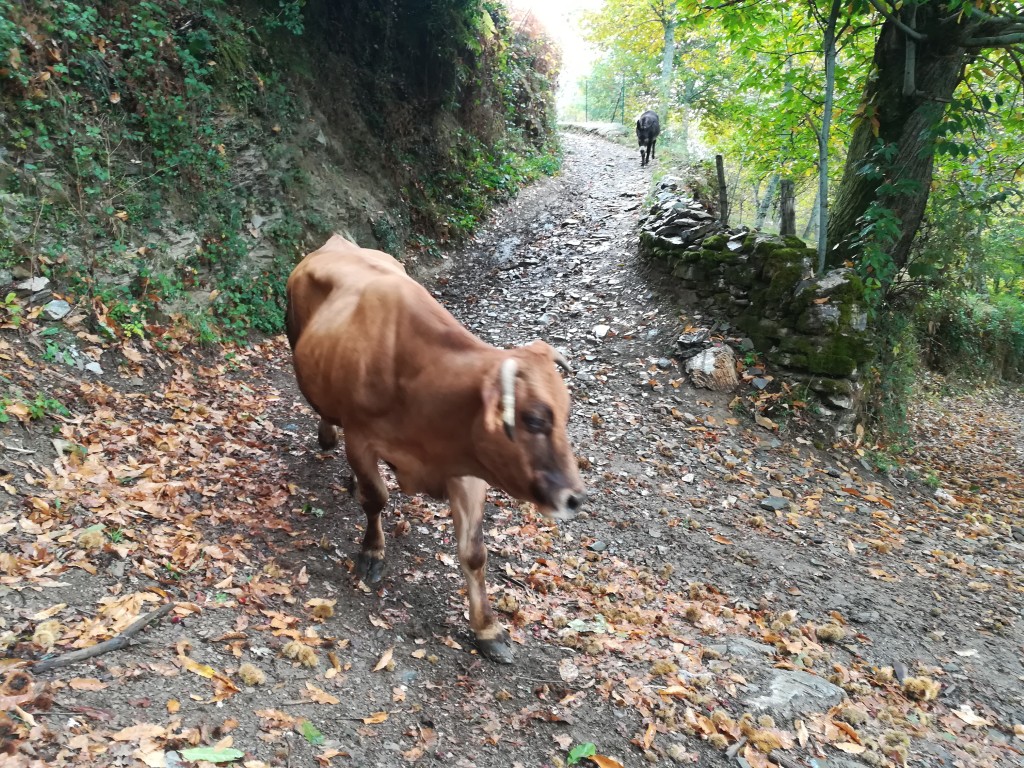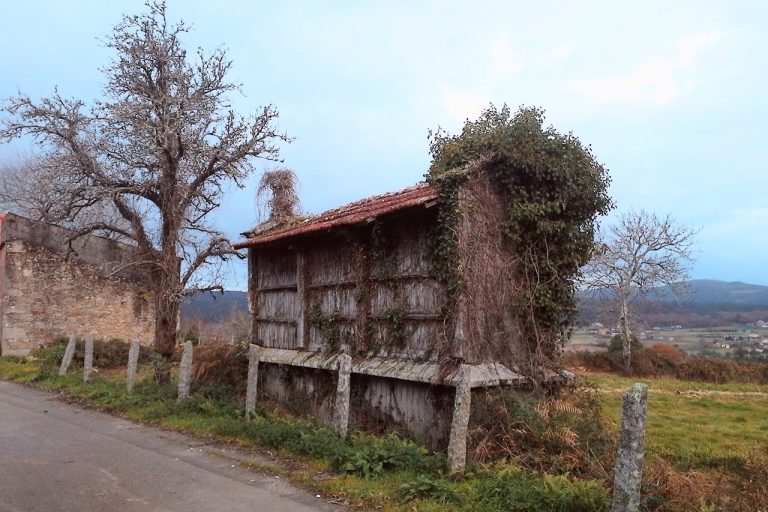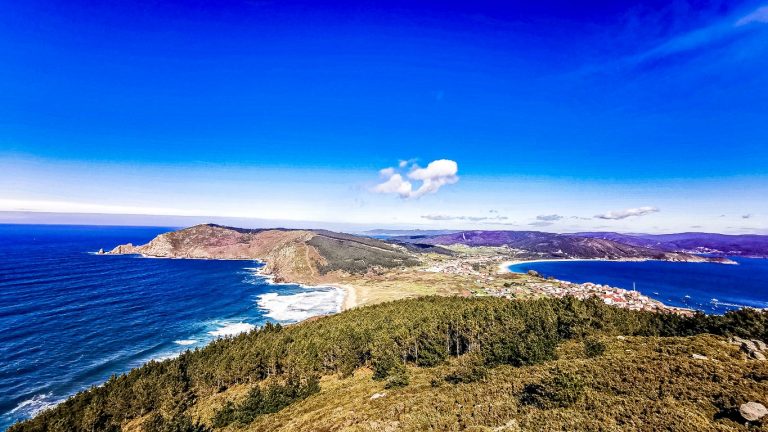
A New Stage – Entry & Atmosphere
The day begins in Villafranca del Bierzo, where the palaces of the Calle del Agua and the Romanesque church of Santiago still bask in the morning light. You leave the Bierzo valley – a fertile paradise of wine, chestnuts, and history – and set out towards the mountains. Today a key stage lies ahead: almost 28 kilometers that will carry you over river valleys and villages, slowly but relentlessly, to the legendary O Cebreiro.
It is not only a physical ascent, but also a spiritual transition: with each meter climbed you draw closer to Galicia, that mystical land which for centuries has welcomed pilgrims with mists, legends, and spirituality. O Cebreiro – the gateway to Galicia – will not simply be a destination, but a highlight of your entire pilgrimage.
Route & Elevation Profile
- Distance: 27.7 km
- Elevation: approx. +950 m / –200 m
- Difficulty: high
- Character: long, steady climbs, steep and demanding from Las Herrerías, last kilometers with an alpine mountain feel.
The stage begins almost harmlessly – flat along the N-VI – and ends in a long, hard ascent. Those wishing to save strength can divide the stage, staying overnight in places like Trabadelo, Vega de Valcarce, Ruitelán, or Las Herrerías.





















Variants
- Official Camino: through the valley of the Río Valcarce, passing small villages, always with options for food and rest.
- Camino duro: from Villafranca via Pradela (a variant with significant elevation and panoramic views over El Bierzo). Only recommended for very fit pilgrims.
Description of the Way – With All Senses
Just beyond Villafranca del Bierzo the Río Valcarce accompanies you, as the Camino rises gently alongside the N-VI. The first kilometers lead you into a green, narrow valley where the slopes gradually close in and the forests grow denser. The soft murmur of the river accompanies your steps as the city’s edges fade behind you.
Soon you reach Pereje, a quiet village whose Magdalena church and old lanes breathe medieval atmosphere. Life here seems unhurried, and for a moment you step into another time. The river remains your companion as you continue to Trabadelo. This place feels livelier, with bars and small shops. Already in the Middle Ages several pilgrim hospitals stood here – today the church of San Nicolás invites you to pause briefly before the way returns to the valley.
The further you move into the Valcarce, the narrower it becomes. At La Portela de Valcarce the valley visibly tightens – a “narrow passage” living up to its name. The mountains seem to close in, and you sense that the plains of El Bierzo are now truly behind you. Shortly afterward you reach Ambasmestas, where the Río Balboa flows into the Valcarce. The small church of San Pedro, as well as traces of the old Roman road, remind you that for millennia paths have converged here.
The following kilometers take you to Vega de Valcarce, a town with a turbulent history. Above its ruins once stood a fortress where even Emperor Charles V spent a night. As you wander its streets, you feel the true ascent drawing near. In Ruitelán time seems to stand almost still. The legend of the hermit San Froilán gives the village a spiritual depth that encourages you to linger a little longer.
Beyond Las Herrerías, once famous for its forges, the real challenge of the day begins. An old stone bridge and the village fountain tell of past centuries – but for you it is above all a moment to refill water and gather strength. From here the way climbs steeply and relentlessly.
Through switchbacks the Camino winds uphill through chestnut and oak forests. In La Faba you step out of the shade into a village clinging picturesquely to the slope. The church of San Andrés invites quiet reflection, and for many pilgrims this is the last rest before tackling the final stretch. Once again the path rises steeply, and soon you reach La Laguna de Castilla – the last village in Castile and León. Galicia now lies within reach.
Beyond the famous stone monument marking the border, the last meters of ascent await. Past the Monumento al Gaiteiro, commemorating the legend of a German pilgrim guided by the sound of a bagpipe, you push on step by step. With burning muscles and pounding heart you take a final stride – and at 1,300 meters you stand at the entrance to O Cebreiro.
Arrival in O Cebreiro – Gateway to Galicia
O Cebreiro is more than just a stage’s end. It is a mythical place that has drawn pilgrims for centuries. The small settlement greets you with a blend of archaic simplicity and deep spirituality. Among the ancient pallozas, the thatched roundhouses of Celtic origin, the wind seems to whisper stories of centuries past. Here people and animals once lived under one roof – a symbol of the harsh yet communal life of the mountains.
The spiritual heart of the village is the Iglesia Santa María la Real, one of Spain’s oldest pre-Romanesque churches. Within it is preserved the Santo Milagro – the Eucharistic miracle of the 14th century, when bread and wine visibly transformed into flesh and blood. The simple stone building radiates a power that has moved pilgrims for centuries. Many linger long here, light candles, and let the silence work upon them.
The Ethnographic Museum, housed in one of the pallozas, tells of the life of the mountain dwellers – of hardship, but also of deep connection to nature. And when, in the evening, the sun sinks behind the Galician mountains and the mists roll like waves through the valleys, you realize you are witnessing a special moment of the Camino. O Cebreiro is no ordinary village – it is a gateway, a threshold, a place where history, faith, and nature come together as one.
Intermediate Places & Highlights
| Location | Distance from Villafranca | Highlight | Tip |
| Pereje | 5.7 km | Magdalena church, medieval character | Short pause by the river |
| Trabadelo | 9.7 km | San Nicolás, old hospitals | Rest & provisions |
| La Portela | 14.2 km | “Narrow pass” of the valley, old forges | Coffee at the gas station |
| Ambasmestas | 15.4 km | River confluence, Roman traces | Quiet transition |
| Vega de Valcarce | 17 km | Castle ruins, Charles V | Small pause |
| Ruitelán | 19.2 km | San Froilán, old church | Spiritual moment |
| Las Herrerías | 21.1 km | Blacksmith tradition, Roman bridge | Last stop before ascent |
| La Faba | 23.7 km | Church of San Andrés, panoramic view | Rest break |
| La Laguna | 26.3 km | Last village in León | Gather strength |
| O Cebreiro | 27.7 km | Pallozas, church, miracle chalice | Stage goal |
Packing & Provision Tips
- Start early to avoid heat on the ascent.
- Carry enough water (from Las Herrerías to O Cebreiro few supplies available).
- Energy snack or chocolate for the final 6 km.
- Warm clothing: O Cebreiro is high, evenings often windy and cold.
Food & Accommodation
All villages along the stage offer lodging and bars. Especially charming:
- Casa Susi (Trabadelo) – family-run albergue with heart.
- Las Herrerías – small country hotels, perfect for splitting the stage.
- La Faba – quiet hostel on the slope, very spiritual.
- O Cebreiro – large pilgrim albergue (104 places), plus pensions and charming country houses.
Culinary Notes
Here Galicia begins – and you can taste it:
- Queso do Cebreiro (D.O.): soft, fresh cheese, often served with honey.
- Pote Gallego: hearty stew with cabbage, potatoes, and pork.
- Porco Celta: meat from an ancient pig breed.
- Chestnut and honey sweets – a delight after the long climb.
What Makes Today Special
This stage is more than an ascent – it is a transition. From the wide plains of the Bierzo valley into the magical mountains of Galicia. From wine and chestnuts to mist, mysticism, and legend.
O Cebreiro is a sacred place: here the first Santiago Cross (Cruz de Santiago) was formed, here kings lingered, and here pilgrims have found inspiration for centuries. Especially awe-inspiring is the small Iglesia Santa María la Real, where the Holy Grail of O Cebreiro is kept. This chalice is linked to a legend known as the Santo Milagro: a devout priest who doubted Christ’s real presence in the bread witnessed during Mass how the host and wine visibly turned into flesh and blood. This Eucharistic miracle made O Cebreiro a center of veneration and remains to this day a symbol of faith, hope, and the Camino’s power.
Reflection at the Stage’s End
In the evening, when the mist dances over the mountains and the pallozas cling to the slopes like ancient guardians, you will feel: this was a day of transformation. The Camino has tested you – with endurance, patience, and sweat. Yet the reward is immense: the view from O Cebreiro, the feeling of having reached Galicia, and the sense that Santiago draws nearer.
📊 Tabular Overview
| Stage | Start | Goal | Distance | Elevation | Difficulty | Intermediate Places |
| 27 | Villafranca del Bierzo | O Cebreiro | 27.7 km | +950 m / –200 m | High | Pereje, Trabadelo, La Portela, Ambasmestas, Vega de Valcarce, Ruitelán, Las Herrerías, La Faba, La Laguna |
🌌 Camino of the Stars:
Villafranca → Pereje → Trabadelo → La Portela → Ambasmestas → Vega de Valcarce → Ruitelán → Las Herrerías → La Faba → La Laguna → O Cebreiro
Have you ever experienced the mists in O Cebreiro? Was it the silence of the mountains or the spirituality of the church of Santa María la Real that touched you most? Share your memories – they bring the Camino to life.


